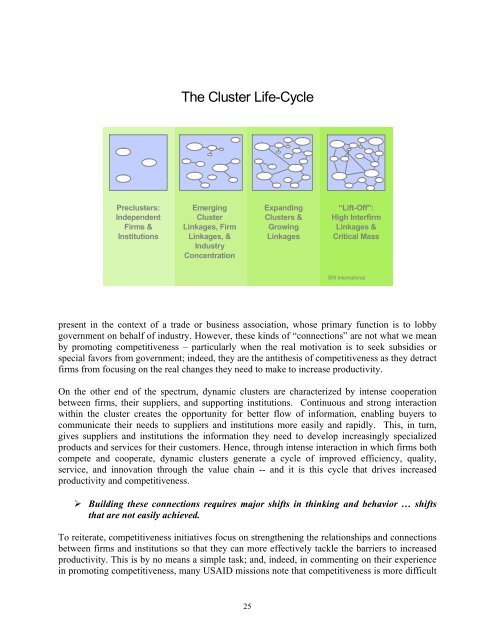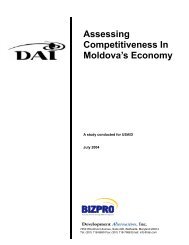Promoting Competitiveness in Practice - Economic Growth - usaid
Promoting Competitiveness in Practice - Economic Growth - usaid
Promoting Competitiveness in Practice - Economic Growth - usaid
Create successful ePaper yourself
Turn your PDF publications into a flip-book with our unique Google optimized e-Paper software.
Preclusters:<br />
Independent<br />
Firms &<br />
Institutions<br />
The Cluster Life-Cycle<br />
Emerg<strong>in</strong>g<br />
Cluster<br />
L<strong>in</strong>kages, Firm<br />
L<strong>in</strong>kages, &<br />
Industry<br />
Concentration<br />
Expand<strong>in</strong>g<br />
Clusters &<br />
Grow<strong>in</strong>g<br />
L<strong>in</strong>kages<br />
“Lift-Off”:<br />
High Interfirm<br />
L<strong>in</strong>kages &<br />
Critical Mass<br />
SRI International<br />
present <strong>in</strong> the context of a trade or bus<strong>in</strong>ess association, whose primary function is to lobby<br />
government on behalf of <strong>in</strong>dustry. However, these k<strong>in</strong>ds of “connections” are not what we mean<br />
by promot<strong>in</strong>g competitiveness – particularly when the real motivation is to seek subsidies or<br />
special favors from government; <strong>in</strong>deed, they are the antithesis of competitiveness as they detract<br />
firms from focus<strong>in</strong>g on the real changes they need to make to <strong>in</strong>crease productivity.<br />
On the other end of the spectrum, dynamic clusters are characterized by <strong>in</strong>tense cooperation<br />
between firms, their suppliers, and support<strong>in</strong>g <strong>in</strong>stitutions. Cont<strong>in</strong>uous and strong <strong>in</strong>teraction<br />
with<strong>in</strong> the cluster creates the opportunity for better flow of <strong>in</strong>formation, enabl<strong>in</strong>g buyers to<br />
communicate their needs to suppliers and <strong>in</strong>stitutions more easily and rapidly. This, <strong>in</strong> turn,<br />
gives suppliers and <strong>in</strong>stitutions the <strong>in</strong>formation they need to develop <strong>in</strong>creas<strong>in</strong>gly specialized<br />
products and services for their customers. Hence, through <strong>in</strong>tense <strong>in</strong>teraction <strong>in</strong> which firms both<br />
compete and cooperate, dynamic clusters generate a cycle of improved efficiency, quality,<br />
service, and <strong>in</strong>novation through the value cha<strong>in</strong> -- and it is this cycle that drives <strong>in</strong>creased<br />
productivity and competitiveness.<br />
Build<strong>in</strong>g these connections requires major shifts <strong>in</strong> th<strong>in</strong>k<strong>in</strong>g and behavior … shifts<br />
that are not easily achieved.<br />
To reiterate, competitiveness <strong>in</strong>itiatives focus on strengthen<strong>in</strong>g the relationships and connections<br />
between firms and <strong>in</strong>stitutions so that they can more effectively tackle the barriers to <strong>in</strong>creased<br />
productivity. This is by no means a simple task; and, <strong>in</strong>deed, <strong>in</strong> comment<strong>in</strong>g on their experience<br />
<strong>in</strong> promot<strong>in</strong>g competitiveness, many USAID missions note that competitiveness is more difficult<br />
25
















